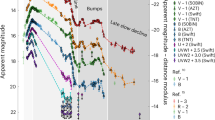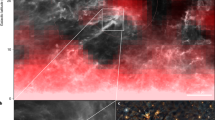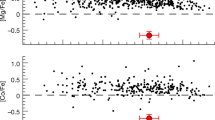Abstract
When a massive star in a binary system explodes as a supernova, its companion star may be polluted with heavy elements from the supernova ejecta. Such pollution has been detected in a handful of post-supernova binaries1, but none of them is associated with a supernova remnant. We report the discovery of a binary G star strongly polluted with calcium and other elements at the position of the candidate neutron star [GV2003] N within the young galactic supernova remnant RCW 86. Our discovery suggests that the progenitor of the supernova that produced RCW 86 could have been a moving star, which exploded near the edge of its wind bubble and lost most of its initial mass because of common-envelope evolution shortly before core collapse, and that the supernova explosion might belong to the class of calcium-rich supernovae — faint and fast transients2,3, the origin of which is strongly debated4–6.
This is a preview of subscription content, access via your institution
Access options
Access Nature and 54 other Nature Portfolio journals
Get Nature+, our best-value online-access subscription
$29.99 / 30 days
cancel any time
Subscribe to this journal
Receive 12 digital issues and online access to articles
$119.00 per year
only $9.92 per issue
Buy this article
- Purchase on Springer Link
- Instant access to full article PDF
Prices may be subject to local taxes which are calculated during checkout




Similar content being viewed by others
References
González Hernández, J. I. et al. Chemical abundances of the secondary star in the black hole X-ray binary V404 Cygni. Astrophys. J. 738, 95 (2011).
Perets, H. B. et al. A faint type of supernova from a white dwarf with a helium-rich companion. Nature 465, 322–325 (2010).
Kasliwal, M. M. et al. Calcium-rich gap transients in the remote outskirts of galaxies. Astrophys. J. 755, 161 (2012).
Kawabata, K. S. et al. A massive star origin for an unusual helium-rich supernova in an elliptical galaxy. Nature 465, 326–328 (2010).
Waldman, R. et al. Helium shell detonations on low-mass white dwarfs as a possible explanation for SN 2005E. Astrophys. J. 738, 21 (2011).
Moriya, T. J. et al. Light-curve and spectral properties of ultra-stripped core-collapse supernovae leading to binary neutron stars. Mon. Not. R. Astron. Soc. 466, 2085–2098 (2017).
Sana, H. et al. Binary interaction dominates the evolution of massive stars. Science 337, 444–446 (2012).
Chini, R., Hoffmeister, V. H., Nasseri, A., Stahl, O. & Zinnecker, H. A spectroscopic survey on the multiplicity of high-mass stars. Mon. Not. R. Astron. Soc. 424, 1925–1929 (2012).
Langer, N. Presupernova evolution of massive single and binary stars. Annu. Rev. Astron. Astrophys. 50, 107–164 (2012).
Podsiadlowski, P., Joss, P. C. & Hsu, J. J. L. Presupernova evolution in massive interacting binaries. Astrophys. J. 391, 246–264 (1992).
Lyman, J. et al. Bolometric light curves and explosion parameters of 38 stripped-envelope core-collapse supernovae. Mon. Not. R. Astron. Soc. 457, 328–350 (2016).
Bhadkamkar, H. & Ghosh, P. Young pre-low-mass X-ray binaries in the propeller phase. Nature of the 6.7-h periodic X-ray source 1E 161348–5055 in RCW 103. Astron. Astrophys. 506, 1297–1307 (2009).
Heinz, S. et al. The youngest known X-ray binary: Circinus X-1 and its natal supernova remnant. Astrophys. J. 779, 171 (2013).
Dickel, J. R., Strom, R. G. & Milne D. K. The radio structure of the supernova remnant G315.4–2.3 (MSH 14-63). Astrophys. J. 546, 447–454 (2001).
Smith, R. C. The discovery of Balmer-filaments encircling SNR RCW 86. Astron. J. 114, 2664–2670 (1997).
Gvaramadze, V. V. & Vikhlinin, A. A. Point X-ray sources in the SNR G315.4−2.30 (MSH 14-63, RCW 86). Astron. Astrophys. 401, 625–630 (2003).
Mignani, R. P., Tiengo, A. & de Luca, A. Optical and X-ray observations of candidate isolated neutron stars in the G315.4–2.3 supernova remnant. Mon. Not. R. Astron. Soc. 425, 2309–2312 (2012).
Sollerman, J., Ghavamian, P., Lundqvist, P. & Smith, R. C. High resolution spectroscopy of Balmer-dominated shocks in the RCW 86, Kepler and SN 1006 supernova remnants. Astron. Astrophys. 407, 249–257 (2003).
Güdel, M. X-ray astronomy of stellar coronae. Astron. Astrophys. Rev. 12, 71–237 (2004).
Asplund, M., Grevesse, N., Sauval, A. J. & Scott P. The chemical composition of the Sun. Annu. Rev. Astron. Astrophys. 47, 481–522 (2009).
Pecaut, M. J. & Mamajek, E. E. Intrinsic colors, temperatures, and bolometric corrections of pre-main-sequence stars. Astrophys. J. Suppl. 208, 9 (2013).
Tognelli, E., Prada Moroni, P. G. & Degl’Innocenti, S. The Pisa pre-main sequence tracks and isochrones. A database covering a wide range of Z, Y, mass, and age values. Astron. Astrophys. 533, A109 (2011).
Hills, J. G. The effects of sudden mass loss and a random kick velocity produced in a supernova explosion on the dynamics of a binary star of arbitrary orbital eccentricity — applications to X-ray binaries and to the binary pulsars. Astrophys. J. 267, 322–333 (1983).
Tutukov, A. & Yungelson, L. Evolution of massive close binaries. Nauchnye Informatsii 27, 70–85 (1973).
D’Antona, F. & Mazzitelli, I. New pre-main-sequence tracks for M less than or equal to 2.5 solar mass as tests of opacities and convection model. Astrophys. J. Suppl. 90, 467–500 (1994).
Sukhbold, T., Ertl, T., Woosley, S. E., Brown, J. & Janka, H.-T. Core-collapse supernovae from 9 to 120 solar masses based on neutrino-powered explosions. Astrophys. J. 821, 38 (2016).
Gvaramadze, V. V. On the origin of two-shell supernova remnants. UV Astronomy: Stars from Birth to Death (eds Gomez de Castro, A. I. & Barstow, M. A. ) 205–210 (2007).
Krause, O. et al. The Cassiopeia A supernova was of type IIb. Science 320, 1195–1197 (2008).
Krause, O. et al. Tycho Brahe’s 1572 supernova as a standard type Ia as revealed by its light-echo spectrum. Nature 456, 617–619 (2008).
Taylor, J. H. A sensitive method for detecting dispersed radio emission. Astron. Astrophys. Suppl. 15, 367–369 (1974).
Manchester, R. N. et al. The Parkes multi-beam pulsar survey. I. Observing and data analysis systems, discovery and timing of 100 pulsars. Mon. Not. R. Astron. Soc. 328, 17–35 (2001).
Appenzeller, I. et al. Successful commissioning of FORS1 — the first optical instrument on the VLT. Messenger 94, 1–6 (1998).
Tody, D. in Astronomical Data Analysis Software and Systems II (eds Hanisch, R. J., Brissenden, R. J. V. & Barnes, J. ) 173–183 (ASP Conf. Ser. 52, 1993).
Greiner, J. et al. GROND — a 7-channel imager. Publ. Astron. Soc. Pac. 120, 405–424 (2008).
Krühler, T. et al. The 2175 Å feature in a gamma-ray burst afterglow at redshift 2.45. Astrophys. J. 685, 376–383 (2008).
Aihara, H. et al. The eighth data release of the Sloan Digital Sky Survey: first data from SDSS-III. Astrophys. J. Suppl. 193, 29 (2011).
Skrutskie, M. F. et al. The Two Micron All Sky Survey (2MASS). Astron. J. 131, 1163–1183 (2006).
Arnouts, S. & Ilbert, O. Le PHARE: Photometric Analysis for Redshift Estimate (2014); http://www.cfht.hawaii.edu/~arnouts/LEPHARE/lephare.html
Hauschildt, P. H., Allard, F. & Baron E. The NextGen model atmosphere grid for 3000 ≤ T eff ≤ 10,000 K. Astrophys. J. 512, 377–385 (1999).
Bagnulo, S., Landstreet, J. D., Fossati, L. & Kochukhov, O. Magnetic field measurements and their uncertainties: the FORS1 legacy. Astron. Astrophys. 538, A129 (2012).
Kochukhov, O., Makaganiuk, V. & Piskunov, N. Least-squares deconvolution of the stellar intensity and polarization spectra. Astron. Astrophys. 524, A5 (2010).
Piskunov, N. E., Kupka, F., Ryabchikova, T. A., Weiss, W. W. & Jeffery, C. S. VALD: The Vienna Atomic Line Database. Astron. Astrophys. Suppl. 112, 525–535 (1995).
Iglesias-Marzoa, R., López-Morales, M. & Jesús Arévalo Morales, M. The rvfit code: a detailed adaptive simulated annealing code for fitting binaries and exoplanets radial velocities. Publ. Astron. Soc. Pac. 127, 567–582 (2015).
Kochukhov, O. in Physics of Magnetic Stars (eds Romanyuk, I. I. & Kudryavtsev, D. O. ) 109–118 (2007).
Shulyak, D., Tsymbal, V., Ryabchikova, T., Stütz, C. & Weiss, W. W. Line-by-line opacity stellar model atmospheres. Astron. Astrophys. 428, 993–1000 (2004).
Bruntt, H. et al. Accurate fundamental parameters for 23 bright solar-type stars. Mon. Not. R. Astron. Soc. 405, 1907–1923 (2010).
Fuhrmann, K., Axer, M. & Gehren, T. Balmer lines in cool dwarf stars. 1. Basic influence of atmospheric models. Astron. Astrophys. 271, 451–462 (1993).
Fossati, L. et al. Late stages of the evolution of A-type stars on the main sequence: comparison between observed chemical abundances and diffusion models for 8 Am stars of the Praesepe cluster. Astron. Astrophys. 476, 911–925 (2007).
Fossati, L. et al. The chemical abundance analysis of normal early A- and late B-type stars. Astron. Astrophys. 503, 945–962 (2009).
Whiteoak, J. B. Z. & Green, A. J. The MOST supernova remnant catalogue (MSC). Astron. Astrophys. Suppl. 118, 329–380 (1996).
Acknowledgements
This work is based on observations collected at the European Southern Observatory, Chile, under programmes 095.D-0061 and 385.D-0198(A). V.V.G. thanks M. G. Revnivtsev (who passed away in November 2016) and M. R. Gilfanov for discussions and acknowledges support from the Russian Science Foundation grant 14-12-01096. This research was supported in part by the National Science Foundation under Grant No. NSF PHY11-25915.
Author information
Authors and Affiliations
Contributions
V.V.G. and N.L. led the project and the manuscript writing. V.V.G., N.L., L.F. and D.C.-J.B. wrote the telescope proposals. L.F. reduced the VLT/FORS2 spectra, performed the spectral analysis and analysed the radial velocity measurements. S.J. and D.C.-J.B performed and analysed the radio observations. I.Y.G. performed the PSF photometry. J.G. and A.R. performed the GROND observations and the SED fitting. N.C. performed part of the absolute wavelength calibration of the VLT/FORS2 spectra and worked on the removal of the spatially variable Hα emission. T.M.T. performed the Monte Carlo simulations of supernova explosions in binary systems. Figures were prepared by V.V.G., N.L., L.F., A.R. and T.M.T. All authors contributed to the interpretation of the data and commented on the manuscript.
Corresponding authors
Ethics declarations
Competing interests
The authors declare no competing financial interests.
Supplementary information
Supplementary information
Supplementary Sections 1–4, Supplementary References, Supplementary Figures 1–3 and Supplementary Tables 1–2. (PDF 277 kb)
Rights and permissions
About this article
Cite this article
Gvaramadze, V., Langer, N., Fossati, L. et al. A solar-type star polluted by calcium-rich supernova ejecta inside the supernova remnant RCW 86. Nat Astron 1, 0116 (2017). https://doi.org/10.1038/s41550-017-0116
Received:
Accepted:
Published:
DOI: https://doi.org/10.1038/s41550-017-0116
This article is cited by
-
Supernovae: The explosion in a bubble
Nature Astronomy (2017)



